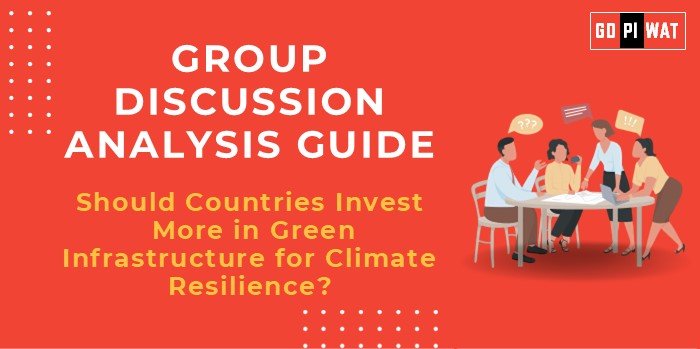🌿 Group Discussion Analysis Guide
Should Countries Invest More in Green Infrastructure for Climate Resilience?
🟢 Introduction to the Topic
Opening Context
Green infrastructure represents a sustainable approach to urban and rural development, designed to combat climate change and enhance resilience. Amid increasing climate disasters, investing in green infrastructure is crucial for reducing carbon footprints and adapting to environmental challenges.
Topic Background
The term “green infrastructure” encompasses natural and semi-natural systems that provide environmental, economic, and social benefits. Examples include urban forests, wetlands, green roofs, and sustainable drainage systems. Global initiatives like the UN’s SDGs (particularly Goal 13: Climate Action) emphasize the need for green infrastructure as a strategy to mitigate climate risks and enhance sustainable urbanization.
📊 Quick Facts and Key Statistics
- Economic Losses from Climate Disasters: $165 billion globally in 2022 (Swiss Re), emphasizing the cost of inaction.
- Carbon Sequestration by Urban Forests: Up to 130 metric tons of CO₂ per hectare annually.
- Urban Flooding Costs: Expected to rise to $1 trillion annually by 2050 without adequate investment (World Bank).
- Green Jobs Potential: 24 million jobs could be created globally by 2030 through investments in green infrastructure (ILO).
🔗 Stakeholders and Their Roles
- Governments: Policy development, funding, and project implementation.
- Private Sector: Investment in technologies and public-private partnerships.
- Local Communities: Participatory planning and maintenance.
- International Organizations: Advocacy, funding, and knowledge sharing (e.g., UNEP, IPCC).
✅ Achievements and Challenges
Achievements
- Urban Green Initiatives: Singapore’s green roofs and parks reduce urban heat by up to 4°C.
- Flood Mitigation: The Netherlands’ Room for the River project has drastically reduced flood risks.
- Carbon Capture: Green infrastructure in New York City absorbs 1.2 million metric tons of CO₂ annually.
Challenges
- Funding Gaps: The $4.1 trillion global funding requirement for nature-based solutions by 2030 is far from met (UNEP).
- Policy Fragmentation: Lack of cohesive frameworks across regions.
- Community Resistance: Poor understanding and perceived economic trade-offs hinder adoption.
🌍 Global Comparisons
- Success: Copenhagen’s Climate Resilient Neighborhoods reduced flooding by 30%.
- Failure: Jakarta’s mangrove restoration faced community pushback due to inadequate consultation.
🛠 Structured Arguments for Discussion
- Supporting Stance: “Investing in green infrastructure is an economically viable way to address climate risks, creating jobs and protecting biodiversity.”
- Opposing Stance: “The high upfront costs and long payback periods of green infrastructure make it impractical for developing nations.”
- Balanced Perspective: “While green infrastructure offers significant benefits, its implementation must be integrated with economic considerations and public awareness campaigns.”
📈 Effective Discussion Approaches
- Opening Approaches:
- “With climate disasters increasing by 83% over the last two decades, green infrastructure is a necessary investment.”
- “Countries like Singapore demonstrate how green infrastructure can reduce urban heat while creating economic value.”
- Counter-Argument Handling:
- Economic concerns: “While the costs seem high, studies show that every $1 spent on climate adaptation saves $4 in recovery costs.”
📊 Strategic Analysis of Strengths and Weaknesses
- Strengths: Climate resilience, biodiversity enhancement, long-term cost savings.
- Weaknesses: High initial costs, dependency on political will.
- Opportunities: Carbon markets, global leadership in sustainability.
- Threats: Economic recessions limiting funding, political resistance.
💡 Connecting with B-School Applications
- Real-World Applications: Integrating green infrastructure into urban planning coursework or sustainability projects.
- Sample Interview Questions:
- “How can public-private partnerships enhance green infrastructure projects?”
- “What lessons can India learn from Singapore’s green urban planning?”
- Insights for B-School Students:
- Explore case studies on climate-resilient cities.
- Analyze the ROI of sustainability investments.


